 A flexible aircraft fuel gauge is one that can be programmed by the pilot. By powerful we mean it can automatically provide data to your GPS or on-board integrated electronic flight instrument system which in turn can calculate fuel status for a particular flight path or destination.
A flexible aircraft fuel gauge is one that can be programmed by the pilot. By powerful we mean it can automatically provide data to your GPS or on-board integrated electronic flight instrument system which in turn can calculate fuel status for a particular flight path or destination.
Difficult to believe but there are many pilots out there that still rely on the old method of calculating fuel use i.e. with a calculator. Flying since before the digital age when aircraft gauges used to be faulty at best, they think the manual way of calculating fuel use is still accurate.
Unfortunately, when flying and the pilot suddenly and inexplicably hears the low fuel warning or unmistakable signs of a fuel starved engine, it might be already too late and the safety of the passengers would be at severe risk.
Manual calculation is okay only if all else is running fine. We mean, what if there is a fuel leak? Or wind resistance causing the engine to burn more fuel – there is little chance of the
 The beauty of an Aircraft Engine Monitoring System and Aircraft Digital Instrument lies not in its looks but in the features it offers and the accuracy of its performance.
The beauty of an Aircraft Engine Monitoring System and Aircraft Digital Instrument lies not in its looks but in the features it offers and the accuracy of its performance.
With over three decades of design experience, in single and twin engine Aircraft Engine Monitoring Systems and Aircraft Digital Instruments; J.P. Instruments is undoubtedly the world leader and the “go to” folks for all your Aircraft Engine Monitoring Systems and Aircraft Digital Instrument requirements.
Parameters can be fed in and should the engine exceed any of these set parameters, the digital instrument provides hard-to-ignore warning to the pilot. With options that include integrated altimeter, airspeed indicator, fuel flow and a several other sensors for electrical systems, engines and fuel systems, Aircraft Engine Monitoring Systems and Aircraft Digital Instrument from J.P. Instruments are a “must have” for pilots of every single and twin engine airplane.
Constant innovation at J.P. Instruments
